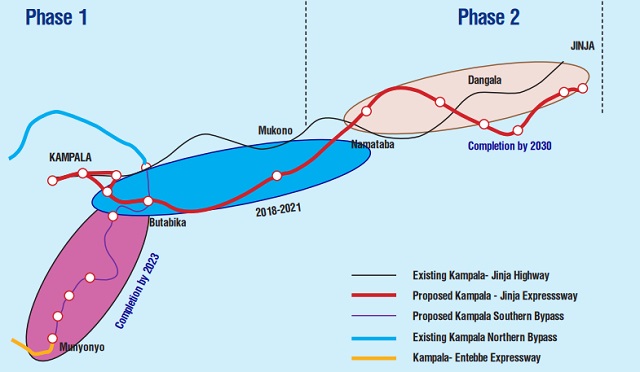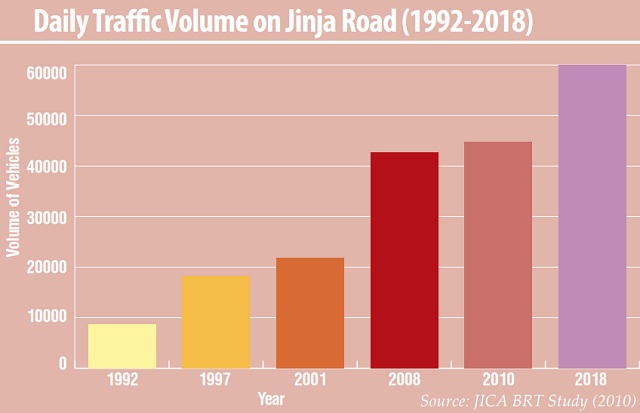
Road transport is the dominant mode in Uganda carrying over 95% of passengers and freight. A study on traffic trends along Kampala city’s major arteries noted an annual growth of 13.3%. Although Jinja Road had the lowest traffic growth rate, it had the biggest volume of traffic. The highest growth rate was observed on Hoima Road. But according to the Preliminary Information Memorandum (PIM) of the expressway, journey time on a 24km stretch is currently 102 minutes.
“If capacity is not improved, by 2037 there will be a complete breakdown in transport reliability,” says the PIM.
While launching the procurement in August 2018, Allen Kagina, the UNRA boss said the expressway would save travellers along the route between 70-120 minutes. She added that the vehicle operating costs and accident rates along this route would also reduce markedly.
The Kampala-Jinja Expressway is part of the infrastructure development of the Northern Corridor –a vital international highway connecting the port of Mombasa in Kenya to the landlocked countries of Uganda, Rwanda, Burundi and the Democratic Republic of Congo.
The project is planned to be undertaken in two phases. Phase one will involve development of the first 35km section from Kampala to Namagunga and the 18km Kampala Southern Bypass (KSB) to provide a bypass to the capital city by linking to the Kampala Entebbe expressway and the Northern Bypass to form a complete ring road around the city.
The largest part of the Kampala-Jinja Expressway will not follow the route of the existing main road from Kampala to Jinja. But the first section of about 2.5km will start at Lugogo Bypass up to Kyambogo following the current route.
At Kyambogo, the new highway will divert southwards, cut through the existing Kinawataka Road and swamps and Kireka-Mbuya valley towards Butabika. Here it will connect with the planned Kampala Southern Bypass which will run from the Northern Bypass junction at Namboole.
The Kampala-Jinja Expressway will then push eastwards through Bukasa, Namanve, Seeta, Mukono to Namagunga. In the early planning about five years ago, the projected completion date of Phase One was 2023. But that appears impossible now.
Meanwhile, Phase two will involve development of the 41km second section of the Kampala-Jinja Expressway from Namagunga to the new Nile Bridge at Njeru. The initial completion date for the second phase was 2030.
The project has been designed to include viaducts, underpasses, overpasses and pedestrian footbridges to improve accessibility for adjacent communities, traffic flow management, minimize disturbance over wetlands and enhance vehicle and pedestrian safety.
 Wastage of money?
Wastage of money?
When completed, the Kampala-Jinja Expressway will become the fourth road that directly links Kampala and Jinja. The main link is the 80km highway through Mabira forest. But motorists can exit Kampala and reach Jinja via the Gayaza-Kalagi-Bukoloto-Njeru route while others can drive up to Mukono and veer off via the Kyetume-Kisoga-Nkokonjeru-Nyenga road.
But taxi drivers like Musoke Bbosa who has operated in the area for over 12 years say the existing access routes are not popular with motorists because they are longer.
“We only use these routes when there is a terrible inconvenience on the main route,” he says.
Surprisingly, however, Musoke told The Independent that he is not enthusiastic about the new project. He thinks it is wastage of resources from the government because, to him, the government should have just expanded the old highway; make it a four lane route to ease congestion on the road.
He is also against the idea of making the expressway a toll road because he says he cannot afford to pay a daily road toll.
“They will probably use it themselves like the Entebbe Expressway. Why should we pay when we are struggling to put food on the table?” he said.
But Ssempebwa from UNRA defended the proposed new expressway.
“The other routes don’t serve the same objective,” he said.
He added: “The expressway will improve road safety, reduce travel times and vehicle operation costs, spur economic growth, lower the cost of doing businesses and improve Uganda’s investment climate and competitiveness.” But first, it must be built and that appears unlikely to happen any time soon.
****
 The Independent Uganda: You get the Truth we Pay the Price
The Independent Uganda: You get the Truth we Pay the Price



good news in time